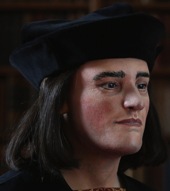Guest Post by Helen Cox
History Matters: Shakespearean Battles at Towton
Helen Cox, author of two excellent books on the Battle of Wakefield, here tells us about her meeting with the Bard at Towton. We are very grateful to Helen for making this article, which was first published on her blog, Helen Rae Rants!, available to us. You can find out more about Helen on Herstory Writing & Interpretation.
On Sunday 14th July, history was made again on the battlefield at Towton in North Yorkshire, when the world-renowned Globe Theatre company performed a Shakespearean marathon – all three parts of Henry VI, at the site where some of the action in Part III actually took place in 1461.
I went with some trepidation, I confess; Shakespeare can be hard going, so the prospect of three plays back-to-back, (starting at 12.30 and finishing at 10 pm, with an hour’s break between them), was slightly daunting. However, thanks to Nick Bagnall’s superb direction and an equally superb cast, it was a joy – beautifully interpreted, easy to follow and altogether riveting. I boggled in amazement at what they achieved with imaginative use of a very simple set; no fancy backdrops or painted scenery, just scaffolding towers and a few bits of cloth – but it became everything from the gates of Orleans to Wars of the Roses killing fields to the Tower of London, and much more besides. (You’ll find some pictures of it, and a link to BBC 1′s Breakfast News item about the plays, on the News page of Herstory Writing & Interpretation).
The way the fighting was rendered was also massively impressive. How will they recreate Towton, (a battle where more than 20,000 men are said to have died), with a cast of 14, I’d wondered beforehand. Well, now I know: with the beating of enormous drums, the clash of swords on scaffolding poles, and a handful of actors facing the audience, performing slow-motion, stylised movements with their weapons. It worked beautifully – as did the well-choreographed one-on-one fight scenes that crop up throughout.
Although all the actors were marvellous, Henry VI, played by Graham Butler, was possibly my favourite. I particularly enjoyed his appearance in Part I; as an infant or young child while much of the action takes place, he naturally does not speak; but he was a dominant, silent presence in his central tower, reacting to the dialogue, shrinking in horror from the violence, studying his book or twiddling his thumbs. It was a clever, subtle, very effective way of evoking this hapless king’s character; and sometimes very funny, as when the juvenile Henry reaches down for an important scroll, only to have it whisked away from his groping fingers. Wonderful. But Mary Doherty also played a corking Margaret of Anjou, especially in Part III when she gleefully slays Richard of York. Simon Harrison’s Richard, Duke of Gloucester was another real treat, portrayed as the classic limping, withered-armed hunchback (archaeology has proved that he wasn’t really like that, but the acting had to fit Shakespeare’s script!). And he made a delicious, gloating villain; also very funny, and (not surprising!) warmly received by a Yorkshire crowd.
The performance ended with a sprightly dance on stage and a standing ovation from the audience – and by heck, those actors had earned it. But I wasn’t sorry to go home, because Part III (featuring the Battle of Towton) had given me the heebie-jeebies. As a member of Towton Battlefield Society, I’ve studied, written about and talked about that battle ad infinitum. I’ve ‘met’ some of the battle dead – at least, their poor mutilated skeletons. And as one of the Society’s Wars of the Roses re-enactors, I’ve been on that field (the site of the Lancastrian camp, close to the location of the mass graves made famous by Channel 4′s documentary, Blood Red Roses), at all hours of the day and night. I’ve even slept there on numerous occasions, waiting, hoping, wanting to feel some frisson of atmosphere – but it never really happened until Sunday. Maybe it was listening to the hours of near-contemporary language that did it… for the first time, I felt the full horror of Towton not just intellectually but physically. Yes, it had really happened, right where we were sitting… and as the evening wore on I kept tensing, expecting a rout of exhausted Lancastrians to come panting over the hill, pursued by screaming Yorkists on horseback, cut down and hacked to pieces; expecting to see blood and body parts around my chair; becoming deeply unsettled.
So I have The Globe Theatre to thank for that – not only the most amazing day of drama I’ve ever enjoyed, but the deepest, most poignant connection with the true history I’ve ever experienced on that field. I commend it to you, if you get chance to go; the company are taking it to three more battlefield sites: Tewkesbury on 4th August, St Albans on 8th August and Barnet on 24th August. (It’s also on at various theatres round the country… but it won’t be quite the same indoors!).
Tags: Shakespeare, Towton, Wars of the Roses




